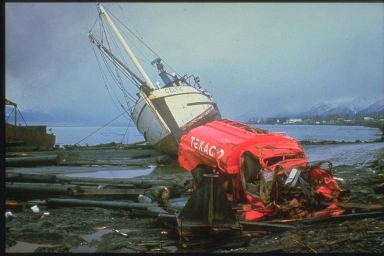The intensity of a tsunami
 Fig. 1: Damage caused by the tsunami of 1964 in Alaska. (Credit: NOAA) |
In order to establish the intensity of a tsunami we use the Sieberg-Ambraseys scale, introduced in 1927 by August Sieberg and subsequently modified by Nicholas Ambraseys in 1962. It is used in European records and is described below:
1. Very light. Wave so weak as to be perceptible only on tide-gauge records.
2. Light. Wave noticed by those living along the shore and familiar with the sea. On very flat shores generally noticed.
3. Rather strong. Generally noticed. Flooding of gently sloping coasts. Light sailing vessels carried away on shore. Slight damage to light structures situated near the coasts. In estuaries reversal of the river flow some distance upstream.
4. Strong. Flooding of the shore to some depth. Light scouring on man-made ground. Embankments and dikes damaged. Light structures near the coasts damaged. Solid structures on the coast injured. Bid sailing vessels and small ships drifted inland or carried out to sea. Coasts littered with floating debris.
5. Very strong. General flooding of the shore to some depth. Quay-walls and solid structures near the sea damaged. Light structures destroyed. Severe scouring of cultivated land and littering of the coast with floating items and sea animals. With the exception of big ships all other type of vessels carried inland or out to sea. Big bores in estuary rivers. Harbor works damaged. People drowned. Wave accompanied by strong roar.
6. Disastrous. Partial or complete destruction of manmade structures for some distance from the shore. Flooding of coasts to great depths. Big ships severely damaged. Trees uprooted or broken. Many casualties.